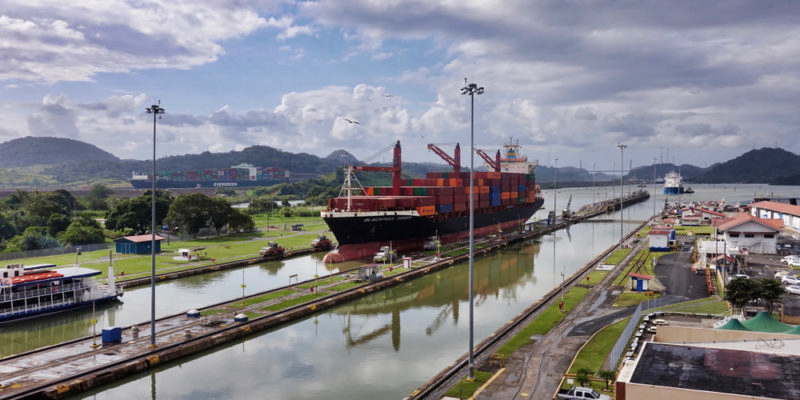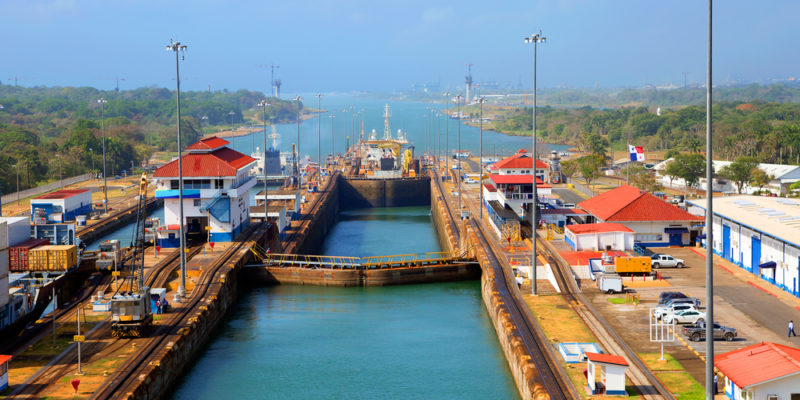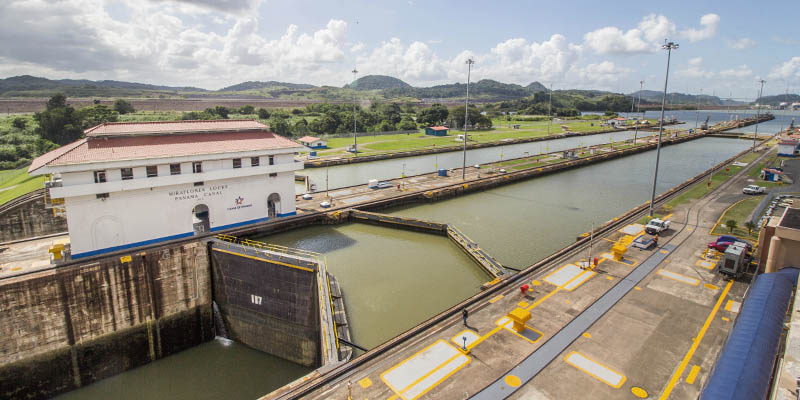We explain what the Panama Canal is, and explore the history of its construction and administration. In addition, we discuss its characteristics and importance.

What is the Panama Canal?
The Panama Canal is an interoceanic waterway that cuts across the Isthmus of Panama in Central America connecting the Caribbean Sea and the Atlantic Ocean with the Pacific Ocean.
The Panama Canal crosses the Isthmus of Panama at its narrowest point, and employs a system of locks to raise and lower ships to different levels. The locks are filled with water to lift ships up to 85 feet (26 m) above sea level until they reach Gatun Lake, the widest point in the canal. After sailing through Gatun Lake, ships are lowered through another set of locks to reach the other side of the canal.
The crossing of the Panama Canal takes approximately 9 hours, which drastically reduces navigation time. Prior to its construction, ships had to sail through the Strait of Magellan at the southernmost end of South America to cross from the Atlantic to the Pacific Ocean.
The canal has a length of 48 miles (77 km). It connects the ports of Balboa on the Pacific Ocean coast with Cristobal in the Caribbean Sea. Each lock of the canal is 1,000 feet (305 m) long, 110 feet (33.5 m) wide, and 85 feet (25.9 m) deep.
The construction of the Panama Canal is considered one of the greatest engineering projects of the 20th century.
- See also: Free zones
History of the Panama Canal

The Isthmus of Panama was already used by pre-Columbian indigenous peoples to travel through one ocean to the other, a route that the Spanish learned during the conquest.
The construction of the Panama Canal went through different stages and projects:
- 1542. King Charles I of Spain proposed the creation of a canal to reduce travel time between Spain and Peru, but technology at the time and Spain's financial situation did not allow it. During the 19th century, the idea of building a canal in Nicaragua was proposed, but the project was discarded for political reasons.
- 1839. The project for the construction of the Panama Canal was assigned to a French company by the government of the then Republic of New Granada. However, due to the difficulties of the work, both the government and the French company lost interest and abandoned the concession shortly after.
- 1879. The French engineer and diplomat Ferdinand de Lesseps presented a project to build a canal across the Isthmus of Panama. He took as a basis the route that had been traced for the failed construction of the Panama Railroad in 1850, and the studies and measurements made by Alexander Von Humboldt in his travels through the area in the early 19th century. In 1879, Ferdinand de Lesseps took up the project after building the Suez Canal in Egypt.
- 1881. Work began amid a yellow fever epidemic, added to the difficulties of the terrain, and the exposure of corporate corruption known as the "Panama Scandal".
- 1882. Work was stopped due to an earthquake that shook the isthmus. Gustave Eiffel, the celebrated French engineer, had proposed the lock system as a solution to the rugged terrain.
- 1888. Funding for the project was interrupted and it was completely abandoned.
- 1904. The United States government resumed the project, and ten years later work was completed.
- 1914. The Panama Canal was finally inaugurated.
Panama Canal expansion. In 2006, the project for the expansion of the Panama Canal was formally announced. The project included the construction of wider and deeper locks to allow the passage of larger ships. The channels were also widened and deepened. The canal expansion, inaugurated in 2016, allowed the transit of ships up to three times larger through the Panama Canal.
Panama Canal administration

Following the inauguration of the Panama Canal in 1914, its control and administration was taken over by the United States until 1977. In that year, the governments of the United States and Panama signed the Torrijos-Carter Treaties, named after the then-president of the United States Jimmy Carter and the Panamanian leader Omar Torrijos.
These treaties established the process for transferring the administration of the canal to Panama, which assumed full control of the operation in 1999. As part of the process, the Panama Canal Authority (ACP) was created in 1997 as the agency of the government of Panama charged with the operation, maintenance, and modernization of the canal.
Maritime traffic through the Panama Canal

According to official data from the Panama Canal Authority, a total of 13,489 ships transited the canal in 2022, averaging about 37 ships per day. Since its inauguration in 1914, it is estimated that over one million ships have passed through the canal.
The majority of the ships that make use of the Panama Canal bear the United States flag, accounting for 68% of the total. In second place are Chinese-flagged ships with 18%, followed by Chilean- and Japanese-flagged ships, which together make up 11% of the total.
What is a Panamax ship?
The construction of the Panama Canal was so important for world commercial shipping that many ships were designed according to the size limits for unimpeded transit through the canal. These ships were given the designation "Panamax".
Over time, as international trade increased, ships were built larger and larger. Vessels that did not meet the dimension criterion to pass through the canal were termed "Post Panamax". Following the 2016 expansion, most "Post Panamax" ships are now able to use the Panama Canal.
Nowadays, ships are designed following the maximum dimension criteria to navigate the expanded canal. These ships are termed "Neo Panamax", with maximum limits of 1,200 feet (366 m) long, 160 feet (49 m) wide, and a maximum draft of 49 feet (15 m). Vessels exceeding these dimensions are not suitable for transit through the Panama Canal.
Importance of the Panama Canal
The opening of the Panama Canal had an enormous impact on international maritime trade by providing a much shorter and more efficient route for ships between the Atlantic and Pacific Oceans.
With the opening of the canal, ships were able to significantly reduce shipping time and costs. This allowed for greater efficiency in international maritime trade and higher cargo volume. In addition, the Panama Canal facilitates trade between Asia, Europe, and the East Coast of the United States, making it one of the world's major maritime routes.
For the Panamanian economy, the canal is a source of income and employment. In 2020, it generated around US$2.7 billion in revenue for the country and employed over 10,000 people directly and indirectly. Moreover, the canal is a key factor in the country's economic development, attracting foreign investment and tourism.
Explore next:
References
- Autoridad del Canal de Panamá. PanCanal
- Legiscomex (s.f). Buques. Legiscomex
- Villa Caro, R (s.f). ¿Por qué existen esclusas en el canal de Panamá? Exponav
- Zanella, L. (2017). Los países que más ocupan el canal de Panamá. T21
Was this information useful to you?
Yes NoThank you for visiting us :)